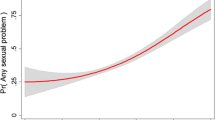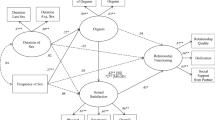Abstract
The aim of the present study was to investigate the prevalence of not reporting sexual attraction in the past year and its associations with factors related to partner relations as well as sexuality-related characteristics in a population-based sample of Finnish twins. The present study was based on a total of 3,540 participants (1,304 men and 2,236 women) aged 33–43 years. A total of 19 men and 73 women reported complete absence of sexual interest in women or men during the past year. Older age was associated with absence of sexual interest in the past year in women, but not men. Individuals who reported absence of sexual interest in the past year were more likely than individuals who reported sexual interest to be single, but those who were in a relationship did not express more dissatisfaction with their relationships. Individuals who reported absence of sexual interest in the past year had had fewer sexual partners and reported less experience of sexual behavior in childhood. Women who reported no sexual interest in the past year, but who were nevertheless sexually active, reported higher frequencies of sexual dysfunctions than matched controls. No significant differences regarding the tendency to fake orgasm were found between the sexually active individuals who reported absence of sexual interest in the past year and the group of matched controls. The present study suggests that absence of sexual interest may be a lifelong phenomenon which does not necessarily affect relationship satisfaction, but is associated with variation in sexual behaviors.
Similar content being viewed by others

References
Aicken, C. R. H., Mercer, C. H., & Cassell, J. A. (2013). Who reports absence of sexual attraction in Britain? Evidence from national probability surveys. Psychology & Sexuality, 4, 121–135.
American Psychiatric Association. (2013). Desk reference to the diagnostic criteria from DSM-5. Arlington, VA: Author.
Asexual Visibility and Education Network (AVEN). (2008). Retrieved March 1, 2012, from http://www.asexuality.org/home/overview.html.
Bailey, J. M., Dunne, M. P., & Martin, N. G. (2000). Genetic and environmental influences on sexual orientation and its correlates in an Australian twin sample. Journal of Personality and Social Psychology, 78, 524–536.
Bogaert, A. F. (2004). Asexuality: Prevalence and associated factors in a national probability sample. Journal of Sex Research, 41, 279–287.
Bogaert, A. F. (2006). Toward a conceptual understanding of asexuality. Review of General Psychology, 10, 241–250.
Bogaert, A. F. (2008). Asexuality: Dysfunction or variation? In J. M. Caroll & M. K. Alena (Eds.), Psychological sexual dysfunctions (pp. 9–13). New York: Nova Biomedical Books.
Bogaert, A. F. (2012). Asexuality and autochorissexualism (identity-less sexuality). Archives of Sexual Behavior, 41, 1513–1514.
Brotto, L. A. (2010a). The DSM diagnostic criteria for hypoactive sexual desire disorder in women. Archives of Sexual Behavior, 39, 221–239.
Brotto, L. A. (2010b). The DSM diagnostic criteria for sexual aversion disorder. Archives of Sexual Behavior, 39, 271–277.
Brotto, L. A., Knudson, G., Inskip, J., Rhodes, K., & Erskine, Y. (2010). Asexuality: A mixed-methods approach. Archives of Sexual Behavior, 39, 599–618.
Brotto, L. A., & Yule, M. A. (2011). Physiological and subjective sexual arousal in self-identified asexual women. Archives of Sexual Behavior, 40, 699–712.
Chasin, C. J. D. (2011). Theoretical issues in the study of asexuality. Archives of Sexual Behavior, 40, 713–723.
DePaulo, B. (2009, December 23). ASEXUALS: Who are they and why are they important? [Web log post]. Retrieved February 29, 2012, from http://www.psychologytoday.com/blog/living-single/200912/asexuals-who-are-they-and-why-are-they-important.
Derogatis, L. R., & Melisaratos, N. (1979). The DSFI: A multidimensional measure of sexual functioning. Journal of Sex and Marital Therapy, 5, 244–281.
Fletcher, G. J. O., Simpson, J. A., & Thomas, G. (2000). The measurement of perceived relationship quality components: A confirmatory factor analytic approach. Personality and Social Psychology Bulletin, 26, 340–354.
Graham, C. A. (2010). The DSM diagnostic criteria for female sexual arousal disorder. Archives of Sexual Behavior, 39, 240–255.
Grenier, G., & Byers, S. (1997). The relationships among ejaculatory control, ejaculatory latency, and attempts to prolong heterosexual intercourse. Archives of Sexual Behavior, 26, 27–47.
Inman, B. A., St. Sauver, J. L., Jacobson, D. L., McGree, M. E., Nehra, A., Lieber, M. M., et al. (2009). A population-based, longitudinal study of erectile dysfunction and future coronary artery disease. Mayo Clinic Proceedings, 84, 108–113.
Jern, P. (2009). Premature and delayed ejaculation: Prevalence, heredity and diagnostic considerations. Unpublished doctoral dissertation, Abo Akademi University, Turku, Finland.
Jern, P., Gunst, A., Sandnabba, N. K., & Santtila, P. (2012). Are early and current erectile problems associated with anxiety and depression in young men? Journal of Sex and Marital Therapy, 38, 325–340.
Jern, P., Piha, J., & Santtila, P. (2013). Validation of three early ejaculation diagnostic tools: A composite measure is accurate and more reliable for diagnosis by updated diagnostic criteria. PLoS ONE, 8, E77676.
Jern, P., Santtila, P., Johansson, A., Varjonen, M., Witting, K., Algars, M., et al. (2008). Indicators of premature ejaculation and their associations with sexual distress in a population-based sample of young twins and their siblings. Journal of Sexual Medicine, 5, 2191–2201.
Jern, P., Santtila, P., Johansson, A., Varjonen, M., Witting, K., von der Pahlen, B., & Sandnabba, K. (2009). Evidence for a genetic etiology to ejaculatory dysfunction. International Journal of Impotence Research, 21, 62–67.
Johansson, A., Jern, P., Santtila, P., von der Pahlen, B., Eriksson, E., Westberg, L., et al. (2013). The genetics of sexuality and aggression (GSA) twin samples in Finland. Twin Research and Human Genetics, 16, 150–156.
Johnson, M. T. (1977). Asexual and autoerotic women: Two invisible groups. In H. L. Gochros & J. S. Gochros (Eds.), The sexually oppressed (pp. 96–109). New York: Associated Press.
Långström, N., & Zucker, K. J. (2005). Transvestic fetischism in the general population: Prevalence and correlates. Journal of Sex and Marital Therapy, 31, 87–95.
Larsson, I., & Svedin, C. G. (2002). Sexual experiences in childhood: Young adults’ recollections. Archives of Sexual Behavior, 31, 263–273.
McCallum, E. B., & Peterson, Z. D. (2012). Investigating the impact of inquiry mode on self-reported sexual behavior: Theoretical considerations and review of the literature. Journal of Sex Research, 49, 212–226.
Meyer-Bahlburg, H. F. L., & Dolezal, C. (2007). The Female Sexual Function Index: A methodological critique and suggestions for improvement. Journal of Sex and Marital Therapy, 33, 217–224.
Muehlenhard, L. C., & Shippee, K. S. (2010). Men’s and women’s report of pretending orgasm. Journal of Sex Research, 47, 552–567.
Nurius, P. S. (1983). Mental health implications of sexual orientation. Journal of Sex Research, 19, 119–136.
Poston, D. L., & Baumle, A. K. (2010). Patterns of asexuality in the United States. Demographic Research, 23, 509–530.
Prause, N., & Graham, C. A. (2007). Asexuality: Classification and characterization. Archives of Sexual Behavior, 36, 341–356.
Rosen, R., Brown, C., Heiman, J., Leiblum, S., Meston, C., Shabsigh, R., et al. (2000). The Female Sexual Function Index (FSFI): A multidimensional self-report instrument for the assessment of female sexual function. Journal of Sex and Marital Therapy, 26, 191–208.
Rosen, R., Cappelleri, J. C., Smith, M. D., Lipsky, J., & Peña, B. M. (1999). Development and evaluation of an abridged, 5-item version of the International Index of Erectile Function (IIEF-5) as a diagnostic tool for erectile dysfunction. International Journal of Impotence Research, 11, 319–326.
Rothblum, E., & Brehony, K. (1993). Boston marriages: Romantic but asexual relationships among contemporary lesbians. Amherst: University of Massachusetts Press.
Scherrer, K. S. (2008). Coming to an asexual identity: Negotiating identity, negotiating desire. Sexualities, 11, 621–641.
Scherrer, K. S. (2010). What asexuality contributes to the same-sex marriage discussion. Journal of Gay and Lesbian Social Services, 22, 56–73.
Sell, R. (1996). The Sell assessment of sexual orientation: Background and scoring. Journal of Gay, Lesbian, & Bisexual Identity, 1, 295–310.
Spector, I. P., Carey, M. P., & Steinberg, L. (1996). The Sexual Desire Inventory: Development, factor structure, and evidence of reliability. Journal of Sex and Marital Therapy, 22, 175–190.
Swash, R. (2012, February). Among the asexual. The Guardian. Retrieved February 29, 2012, from http://www.guardian.co.uk/lifeandstyle/2012/feb/26/among-the-asexuals.
Wiederman, M. (1999). Volunteer bias in sexuality research using college student participants. Journal of Sex Research, 36, 59–66.
Wiegel, M., Meston, C., & Rosen, R. (2005). The Female Sexual Function Index (FSFI): Cross-validation and development of clinical cutoff scores. Journal of Sex and Marital Therapy, 31, 1–20.
Witting, K., Santtila, P., Jern, P., Varjonen, M., Wager, I., Höglund, M., et al. (2008). Evaluation of the Female Sexual Function Index in a population based sample from Finland. Archives of Sexual Behavior, 37, 912–924.
Acknowledgments
This research was financed by Grant No. 210198 from the Academy of Finland and a Center of Excellence Grant No. 21/22/05 from the Stiftelsen för Åbo Akademi Foundation.
Author information
Authors and Affiliations
Corresponding author
Rights and permissions
About this article
Cite this article
Höglund, J., Jern, P., Sandnabba, N.K. et al. Finnish Women and Men Who Self-Report No Sexual Attraction in the Past 12 Months: Prevalence, Relationship Status, and Sexual Behavior History. Arch Sex Behav 43, 879–889 (2014). https://doi.org/10.1007/s10508-013-0240-8
Received:
Revised:
Accepted:
Published:
Issue Date:
DOI: https://doi.org/10.1007/s10508-013-0240-8



